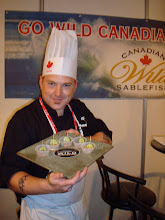Sustainability. I would not be the first person to tackle this topic in recent times. And so I will not, exactly. Instead, I am going to focus on a fish that guiltlessly replaces the Chilean Seabass as a commercially viable, environmentally conscious and highly sustainable fish, that tastes as if it should be criminal to consume. It is called Sablefish and I almost feel guilty eating it.
As a chef and a seafood professional, my biggest issue with seafood choices such as Tilapia and Pangasius are that they don't seem to justify a high ticket price or a place on a white table cloth menu. Both are fine to eat and assuming that you trust the provenance of the catch you are eating, are quality seafood options. However, they are simply put, boring.
When I bite into a piece of fish at a fine restaurant, I want to be as impressed as if I am biting into a piece of Prime Hanger Steak or a Kuraboto pork chop. And I seldom find this to be the case, unless I choose to eat "avoid" species such as Grouper and Chilean Seabass which I have sworn off.
Enter the Sablefish, or Anoplopoma fimbria. Long sought after in Japan, Black Cod or Sablefish(Canada) is a member of the Cod family and is harvested, generally by traps in the Pacific Ocean ranging from British Columbia to Alaska to Japan. This fishing method reduces by catch to almost 0% and causes very little environmental damage.
According to Mark Baggio, of the Canadian Sablefish Association, the Canadian fleet generally produces J-Cut, or head off and collar off, Frozen at Sea (FAS) fish of between 4-7 pounds. The techniques they employ in this relatively small fishery (about 2500 metric tons per year) ensure a viable healthy commercial fishery for the foreseeable future. Marine Stewardship Counsel gives both Alaskan and Canadian Sablefish a “best choice” rating.
As a very delicate protein, Sablefish is most consistent when rapidly and deeply frozen at sea within minutes of being caught. The entire Canadian Fleet utilizes this method of quality preparation. After a good thaw in the refrigerator, the fillets will more readily come off the bone. A simple salt brine will firm up the meat for easier preparation.
Although the pearl like color and thick meaty flakes are a seafood lovers dream, one of the finest qualities of the Sablefish is its incredibly high oil content and silky delicious flavor. Due to the depth and slow rate at which it grows, the Sablefish develops very high Omega 3 oil levels similar to Wild Salmon. I was able to easily sauté this fish with no oil on a hot pan. It produced enough oil that I had to wipe my pan between each portion. And the flavor and texture is absolutely flawless with none of the potentially “fishy” qualities that can scare consumers.
Best if baked or smoked, Sablefish will quickly convert even the pickiest chef. And most importantly, despite my suspicious instincts, it is a choice I can feel good about.
Please visit the Canadian Sablefish Association homepage for more detailed info about this excellent fish:
http://www.canadiansablefish.com/
Please refer to the following links to learn more about sustainable seafood choices:
http://www.msc.org/track-a-fishery/certified/certified-fisheries-on-the-map
http://www.montereybayaquarium.org/cr/seafoodwatch.aspx
Bon Appetite!
Friday, December 18, 2009
Subscribe to:
Post Comments (Atom)


2 comments:
Great post and links! It's interesting to know this info about Sablefish
Very interesting post. I have never tried Sablefish but upon reading this, I am determined to find it. Thanks for sharing and keep up the good work!!
Post a Comment